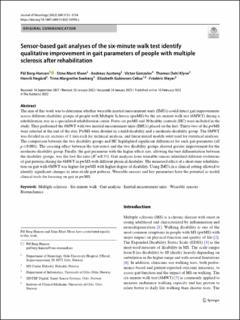| dc.contributor.author | Berg-Hansen, Pål | |
| dc.contributor.author | Moen, Stine Marit | |
| dc.contributor.author | Austeng, Andreas | |
| dc.contributor.author | Gonzalez, Victor | |
| dc.contributor.author | Klyve, Thomas Dahl | |
| dc.contributor.author | Negård, Henrik | |
| dc.contributor.author | Seeberg, Trine Margrethe | |
| dc.contributor.author | Celius, Elisabeth Gulowsen | |
| dc.contributor.author | Meyer, Frederic | |
| dc.date.accessioned | 2023-03-03T12:44:38Z | |
| dc.date.available | 2023-03-03T12:44:38Z | |
| dc.date.created | 2022-02-23T09:59:38Z | |
| dc.date.issued | 2022 | |
| dc.identifier.citation | Journal of Neurology. 2022, 269, 3723-3734. | en_US |
| dc.identifier.issn | 0340-5354 | |
| dc.identifier.uri | https://hdl.handle.net/11250/3055765 | |
| dc.description.abstract | The aim of this work was to determine whether wearable inertial measurement units (IMUs) could detect gait improvements across different disability groups of people with Multiple Sclerosis (pwMS) by the six-minute walk test (6MWT) during a rehabilitation stay in a specialized rehabilitation center. Forty-six pwMS and 20 healthy controls (HC) were included in the study. They performed the 6MWT with two inertial measurement units (IMUs) placed on the feet. Thirty-two of the pwMS were retested at the end of the stay. PwMS were divided in a mild-disability and a moderate-disability group. The 6MWT was divided in six sections of 1 min each for technical analysis, and linear mixed models were used for statistical analyses. The comparison between the two disability groups and HC highlighted significant differences for each gait parameter (all p < 0.001). The crossing effect between the test–retest and the two disability groups showed greater improvement for the moderate-disability group. Finally, the gait parameter with the higher effect size, allowing the best differentiation between the disability groups, was the foot flat ratio (R2 = 0.53). Gait analyses from wearable sensors identified different evolutions of gait patterns during the 6MWT in pwMS with different physical disability. The measured effect of a short-time rehabilitation on gait with 6MWT was higher for pwMS with higher degree of disability. Using IMUs in a clinical setting allowed to identify significant changes in inter-stride gait patterns. Wearable sensors and key parameters have the potential as useful clinical tools for focusing on gait in pwMS. | en_US |
| dc.language.iso | eng | en_US |
| dc.publisher | Springer | en_US |
| dc.rights | Navngivelse 4.0 Internasjonal | * |
| dc.rights.uri | http://creativecommons.org/licenses/by/4.0/deed.no | * |
| dc.title | Sensor-based gait analyses of the six-minute walk test identify qualitative improvement in gait parameters of people with multiple sclerosis after rehabilitation | en_US |
| dc.type | Peer reviewed | en_US |
| dc.type | Journal article | en_US |
| dc.description.version | publishedVersion | en_US |
| dc.rights.holder | © The Author(s) 2022. | en_US |
| dc.source.pagenumber | 3723-3734 | en_US |
| dc.source.volume | 269 | en_US |
| dc.source.journal | Journal of Neurology | en_US |
| dc.identifier.doi | 10.1007/s00415-022-10998-z | |
| dc.identifier.cristin | 2004748 | |
| dc.relation.project | Norges forskningsråd: 270791 | en_US |
| cristin.ispublished | true | |
| cristin.fulltext | original | |
| cristin.qualitycode | 2 | |

